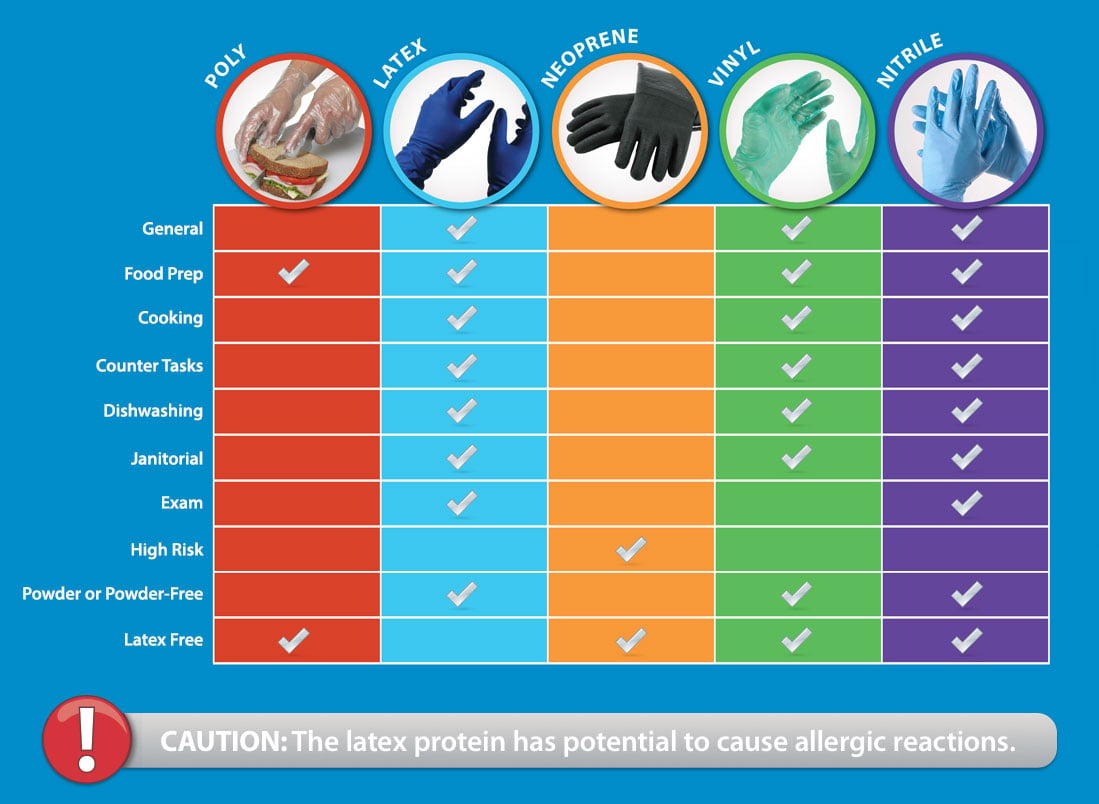The Benefits of Latex Gloves
Latex gloves offer a durable, yet disposable, option for maintaining hygiene in your foodservice kitchen. Not only do disposable gloves protect your hands from contaminants and potentially harmful chemicals, but they prevent cross-contamination and help you practice proper food safety. Learn everything you need to know about latex, latex allergies, and how latex gloves compare to other types of materials below.
Shop All Latex GlovesWhat Is Latex?
Latex is a mix of proteins and compounds that is found naturally in some plants and trees. The latex starts out as a liquid, but it’s eventually turned into a rubbery material that has many different uses in a variety of industries. Natural latex is different from synthetic latex, which is made from chemicals and is used to make things like latex paint.

What Is Latex Used For?
Latex is used to make many common items like disposable gloves, medical equipment, balloons, shoes, tires, and rubber toys, among other things. You can find latex products in many different settings, and it’s common in the foodservice industry as well as medical and dental fields.
What is a Latex Allergy?
A latex allergy is when someone has a reaction to the proteins in natural latex. There are different types of latex allergies, and some people have mild reactions while others can develop serious medical issues when coming into contact with latex. According to the CDC, between 1 and 6% of the general population have latex allergies. As a result, you should be careful when using latex products around customers or with people who may have an allergy.
In 2017 the FDA issued a ban on powdered latex gloves in medical and dental fields, because it can have a negative effect on the patient if they have a latex allergy.
Powdered vs Powder Free Gloves

There are two main types of latex gloves that you can choose from, powdered and powder-free. Each type has its own pros and cons and is ideal for different types of situations.
Powdered Latex Gloves
Powdered latex gloves have a powder on the inside that makes them easy to slip on and off and prevents the latex from sticking to your hands, which is ideal if your staff members are constantly taking off their gloves and replacing them with a new pair.
The powder inside the glove is cornstarch, which prevents irritation unlike previous powders used in gloves. In addition to making the gloves easier to put on, the powder keeps your staff's hands dry and comfortable. This type of disposable glove is also more resistant to tears and rips than powder-free options.
Powder-Free Latex Gloves
After the FDA ban, powder-free latex gloves have become much more prevalent in the medical industry, and they are also common in foodservice settings. The main benefit of powder-free gloves over powdered options is that they won't leave a messy residue on your hands or equipment, which is essential in foodservice settings. Additionally, new types of powder-free gloves are just as easy to put on as powdered options, making them an excellent replacement to other powdered gloves.
Alternatives to Latex Gloves
There are four main disposable glove alternatives to latex: nitrile, poly, neoprene, and vinyl. All four have various benefits that make them good for different settings and are great to have extra in case of an emergency. Check out the graphic below to learn which type of disposable glove is right for your task:

Latex vs Nitrile Gloves
Nitrile gloves are one of the best alternatives to latex gloves because you can use them for many of the same tasks as latex gloves, but you don't have to worry about latex allergies. Nitrile gloves are a perfect choice for hospitals, dental clinics, and other medical facilities because of their excellent chemical resistance which is much needed during an international pandemic. Here are a few benefits of using nitrile gloves in your medical practice or foodservice establishment:
- The material is very resistant to chemicals, which is perfect for cleaning or dealing with hazardous items.
- Nitrile gloves are thin but strong. As a result, they provide excellent tactile sensitivity, which is essential when completing delicate medical tasks.
- They mold to your hands tightly and comfortably.
- There is no powder, so they don't leave a residue on your hands.
- They are latex-free, so you can use them without fear of causing an allergic reaction.
Latex vs Vinyl Gloves
Vinyl gloves are another popular alternative to latex gloves, and you can find them in many types of foodservice establishments. Similar to latex, there are also powdered and powder free versions of vinyl gloves. Vinyl gloves are also easy to slip on, comfortable, and inexpensive, and you can choose thin vinyl gloves for assembling food or thick options for cleaning tasks. Here are a few benefits to switching to disposable vinyl gloves:
- Vinyl is very cost-effective compared to nitrile and latex.
- There are both thin and thick options, so you can use the thin ones when handling food and the thick ones when cleaning.
- Vinyl is latex free and there are no associated allergies, so everyone can use them.
- These products have a looser fit, which makes them comfortable and easy to put on.

When it comes to disposable gloves, there are many different options, so it can be hard to choose. No matter what disposable glove you choose from, ensure you have the proper gloves and sanitation supplies to pass all of your health inspections and ensure you are providing quality service to your customers or guests.
Latex gloves are an ideal option because they're durable, fitted, and comfortable, but they may not work if you have employees or customers with latex allergies. Fortunately, nitrile and vinyl are excellent alternatives. With so many options to choose from, it's easy to find disposable gloves that fit your establishment's needs and keep you and your employees protected during these times.



